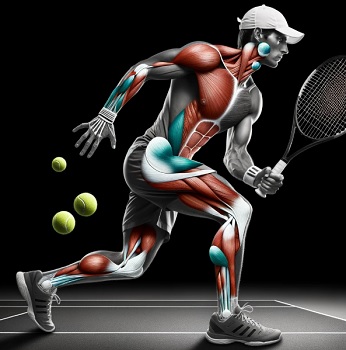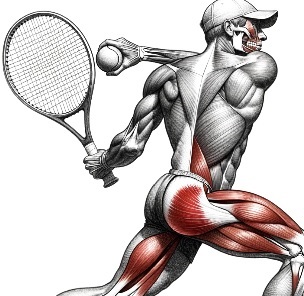Muscles engaged in tennis

Tennis is not just a game of strategy and skill, but also a full-body workout that engages various muscle groups. Whether you’re hitting a powerful serve or chasing down a drop shot, your body is putting several muscles to work. Let’s delve into the primary muscles that are activated and strengthened when playing tennis.
Shoulder Muscles (Deltoids)
In the dynamic world of tennis, the deltoid muscles, which cap the shoulders, are among the most vigorously engaged. Situated in a prime position, these muscles are divided into three distinct sections: the anterior (front), lateral (middle), and posterior (rear) deltoids. Each section has a unique role in the complex motions of tennis. For instance, when a player launches into a powerful serve, it’s the anterior deltoid that initiates the upward thrust of the arm. Conversely, the posterior deltoid plays a more pronounced role during backhand strokes, aiding in the retraction and extension of the arm. The lateral deltoid, on the other hand, is essential for stabilizing the shoulder and ensuring the arm moves away from the body in a controlled manner, especially during wide forehand shots. This muscle group’s comprehensive engagement in tennis makes it paramount for players to regularly strengthen and stretch their deltoids, ensuring both power in their shots and protection against potential injuries.
Forearm Muscles (Wrist Flexors and Extensors) in Tennis:
The forearm, often an unsung hero in tennis, houses a complex network of muscles that are vital for racket control and ball precision. Among these, the wrist flexors and extensors stand out for their paramount roles. The wrist flexors, located on the palm side of the forearm, contract to bend the wrist, aiding in the preparation and follow-through of both forehand and backhand strokes. They ensure that the racket is held with a firm yet flexible grip, allowing for minute adjustments during play. On the flip side, the wrist extensors, found on the back of the forearm, work to extend and stabilize the wrist, especially during powerful serves and volleys. Their coordinated action with the flexors ensures a balanced and controlled swing, providing the finesse required for drop shots or the force needed for aggressive baseline play. For tennis players, maintaining the strength and flexibility of these muscles is crucial, not just for performance but also to guard against strains and overuse injuries that the sport might pose.
Upper Arm Muscles (Biceps and Triceps)
Within the realm of tennis, the upper arm muscles, namely the biceps and triceps, are instrumental in dictating the power and precision of every shot. The biceps, situated on the front of the upper arm, play a pivotal role in the flexion and stabilization of the arm, particularly during the preparation and execution of backhand strokes. Their contraction allows players to maintain a steady racket face while countering high-speed balls. In contrast, the triceps, located on the back of the upper arm, spring into action predominantly during forehand shots, extending the elbow and adding force to the swing. Additionally, they’re crucial during serves, where they work in tandem with the shoulder muscles to generate maximum racket velocity. The symbiotic relationship between the biceps and triceps ensures that tennis players can swiftly alternate between different strokes, delivering both power-packed smashes and delicate drop shots. As such, strengthening and conditioning these muscles are imperative for optimal performance and injury prevention on the court.
Core Muscles (Rectus Abdominis and Obliques)
At the very core of a tennis player’s strength and agility lie the rectus abdominis and oblique muscles, essential powerhouses for every movement on the court. The rectus abdominis, often referred to as the « six-pack » muscle, spans the front of the abdomen and is pivotal for maintaining posture, generating force in serves, and aiding in swift forward and backward movements. Its contractions allow players to bend forward effectively, crucial for low ball retrievals or sudden net plays. In tandem with this, the obliques, positioned on the sides of the abdomen, come into play during the rotational motions inherent to tennis. Whether it’s a cross-court forehand or a twist to deliver a powerful serve, the obliques facilitate the torso’s turning and tilting, granting players the ability to execute shots with precision and speed. Beyond just shot-making, these core muscles also act as stabilizers, protecting the spine and reducing the risk of injuries. Thus, for tennis aficionados, a robust and agile core isn’t just about athletic aesthetics; it’s the very foundation of their game.
Hip and Glute Muscles (Gluteus Maximus, Minimus, and Medius)
In the kinetic ballet that is tennis, the hip and glute muscles—comprising the gluteus maximus, minimus, and medius—stand as essential pillars of strength and mobility. The gluteus maximus, the largest muscle in the human body, is responsible for the powerful extension of the hip joint, enabling players to launch forward in aggressive sprints or leap to intercept an overhead smash. In contrast, the gluteus medius and minimus, nestled deeper and toward the side of the hip, play a more nuanced role. They assist in hip abduction, moving the leg away from the body’s midline, and are crucial for maintaining pelvic stability, especially during lateral movements or when a player pivots to change direction swiftly. This trio’s combined efforts ensure that tennis players can navigate the court with agility, balance, and explosive power, whether they’re darting to the net for a volley or sliding into a wide baseline shot. Given their pivotal role in tennis dynamics, regular strengthening and flexibility exercises targeting these muscles are indispensable for any player seeking peak performance and injury prevention.

Upper Leg Muscles (Quadriceps and Hamstrings)
In the fast-paced arena of tennis, the upper leg muscles, specifically the quadriceps and hamstrings, emerge as vital contributors to every player’s agility and power. The quadriceps, a group of four muscles at the front of the thigh, are the primary drivers for extending the knee and propelling a player forward. Whether it’s a rapid sprint to the net or a sudden stop to return a baseline shot, the quadriceps work tirelessly to generate the necessary force. Complementing them are the hamstrings, located at the back of the thigh. These muscles play a dual role: they aid in bending the knee and also in extending the hip, crucial actions when reaching out for a low ball or preparing for an overhead serve. Together, the harmonious interplay between the quadriceps and hamstrings ensures that a tennis player can move with speed, stability, and dexterity across the court. Given the intense demands tennis places on the upper legs, regular conditioning of these muscles is essential, both to amplify performance and to safeguard against potential strains or injuries.
Calf Muscles (Gastrocnemius and Soleus)
The court’s rhythm and pace in tennis often hinge on the power and resilience of the calf muscles, specifically the gastrocnemius and soleus. The gastrocnemius, with its distinctive two-headed appearance, sits prominently on the back of the lower leg. This muscle springs into action during explosive movements, such as quick starts, jumps for overhead shots, or sudden directional changes. Its strength is pivotal for pushing off the ground and achieving those split-second accelerations. Nested beneath the gastrocnemius lies the soleus, a flatter muscle that plays a more enduring role. It provides stability during prolonged rallies, aids in deceleration when slowing down from a sprint, and is fundamental during the push-off phase of walking and running, ensuring sustained play without fatigue. Together, these calf muscles bear the brunt of the impact each time a tennis player’s foot lands on the court, making them crucial shock absorbers. Given their significance in tennis mechanics, regular stretching and strengthening of these muscles is vital not only for optimizing court performance but also for minimizing injury risks.
Conclusion: Tennis is a fantastic sport that provides a comprehensive workout for the body. It not only improves cardiovascular endurance but also strengthens various muscle groups. Whether you’re a professional player or a weekend enthusiast, understanding the muscles involved can help tailor your training and prevent injuries.
